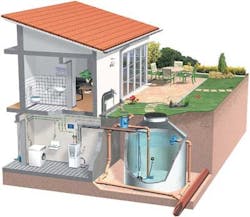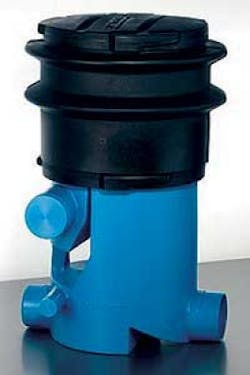Rainwater Catchment and Onsite Water Reuse Steadily Increasing in U.S.
By Christopher Keiger
Rainwater harvesting as a means of water conservation will continue to become increasingly important in the United States as many areas of the country have now reached their limitations and will find it difficult to sustain future population growth. This is particularly evident in arid states and drought-prone regions that have suffered shortages in recent years. Even under normal water conditions, water managers in thirty-six states anticipate water shortages within the next five years. In addition, climate change, significant infrastructure decay, and pollution of existing sources will stretch the current supply and quality of water with the subsequent effects on human health, economic activity and the environment.
The current situation in the United States is that a majority of homes and businesses continue to use potable water for non-potable needs. About 1/3 of all fresh water demand in the U.S. is for irrigation, which places a heavy burden on existing water treatment infrastructure. The cost of providing potable water to the public continues to rise and with limited water resources it is becoming evident that this model is not sustainable.
European countries, parts of Asia, Australia, as well as volcanic and coral formed islands and coastal areas throughout the world often have no choice but to rely on rainwater harvesting and water reuse programs because of limited surface water and groundwater supplies. Coastal areas, volcanic- and/or coral-formed islands commonly have limited or poor quality groundwater and their supply wells are often susceptible to saltwater intrusion.
There are three main sources of water for residential and commercial properties: the municipal or well potable supply, rainwater falling onto the property catchment area and wastewater discharged from the property. The historic approach has been to use the potable supply for all water uses, seek ways to divert the stormwater to prevent flooding of the property and to regard the used grey and black water as a waste.
Capture, Filter, Store and Reuse
Perhaps the easiest of these water conservation concepts to implement is the recycling of harvested rainwater, which, although not a new concept, has become increasingly practical and affordable in residential and commercial applications. The technology required to capture, filter, store and reuse rainwater has made significant advances worldwide as cost-effective components have become available and a better understanding of the water quality requirements and definition of “fit for purpose” is provided by regulators.
Understanding the local regulatory requirements is an essential first step in implementing a water reuse system. U.S. regulation for water reuse is very fragmented and managed at a state or county health department level. The definition of fit for purpose is important in balancing the health-based risk assessments with the desire for an affordable solution.
Many states are introducing standards that reflect this tiered approach to performance standards. An example of this is wastewater treated for use as irrigation water using a subsurface drip system, which limits any health exposure risk compared to water recycled for use in toilets, which poses a greater risk. The discussion of treatment standards for reclaimed water focuses largely on whether the treatment system is capable of consistently achieving an appropriate water quality, is fail safe in operation and is “fit for purpose,” which in turn is dependant on the exposure levels associated with the water use. It is becoming recognized that the key to ensuring safe and reliable reuse water is to implement multiple barriers that control microbiological pathogens and contaminants that may enter the water supply systems.
Having determined the regulatory requirements, deciding what the water will be used for, the quantities required, and determining the quantities of water available are the next steps in the design of a water reuse system.
Typical potable water demands that could be accomplished with non-potable water (harvested rainwater) include landscape irrigation, agriculture/livestock needs, industrial requirements including cooling towers and boilers, fire suppression/protection, laundry washing, pool/pond filling, toilet flushing and vehicle washing.
From the home or business owner’s perspective, the system needs to be easy to maintain and have a reasonable return on investment. There are six fundamental components of a rainwater harvesting system:
1. Catchment surface: Determining whether the proposed project is a system retrofit or new construction, and identifying the type of catchment surface (e.g., roof type) are important considerations in system design and component selection.
2. Gutters and downspouts: These channel water from the roof to ground level and need to be routed to a collection point on the way to the storage tank.
3. Filters, leaf screens, first flush diverters and/or roof washers: These are components that remove debris, dust and dirt from the captured rainwater. They can be either inserted into the downspouts to filter the water before it gets to the storage tank or be incorporated into the storage vessel.
4. Rainwater storage/containment vessel or cistern: The typical storage tank size ranges from 300 to 5,000 gallons for residential systems and 5,000 to 100,000 gallons or more for commercial systems. Most tanks are typically in a vertical cylinder or low-horizontal cylinder configuration. Depending on the site suitability, storage tanks can be located above ground or below ground and are constructed of various materials including plastic, fiberglass, precast concrete, metal or wood.
5. Reuse treatment/purification: Filters and other methods of treatment include but are not limited to screen mesh, sand filtration or membranes for non-potable reuse. UV disinfection and/or reverse osmosis may allow potable reuse, depending on local regulation.
6. Distribution and system controls: Typically systems are either gravity fed or pumped to the end use. Residential systems sometimes use gravity (aboveground storage) or various types of pumps, depending on the complexity of the system. It is important to ensure that the system functionality is consistent with local plumbing standards. A pneumatic or remote sonic device that measures the water level in the tank is typically mounted either at the tank or in the building. System controls that monitor the water level in the tank and switch automatically to municipal supply and/or well water intake are common for larger, more complex systems. This feature allows the water level in the tank to be maintained regardless of the amount of rain collected and can monitor the flow of total water used (harvested water versus replenishment water). This configuration requires a backflow preventer or an air gap to ensure communication does not occur between the harvested rainwater and the water mains.
Figure 2: Example of a volume filter.
Rainwater harvesting programs have been highly successful in European and Australian markets the practice is becoming widely used for toilet flushing and clothes washing. Where irrigation is a key use of water for a homeowner and supply is sufficient, a reasonable target would be to achieve a 70% reduction in potable water usage. Examples include school applications which have achieved close to 100% reduction in non-potable water consumption where rainwater is collected on the roofs and used in toilets and urinal flushing, and wastewater is reused for subsurface drip irrigation, which is automatically regulated using soil moisture tensiometers, on the playing fields. This approach can also provide the nutrient requirements in these grassed or landscaped areas without the need for additional fertilizer.
Other water conservation solutions include incorporating membrane treatment into urban settings. The Solaire (Battery Park City, NY) is the first residential water reuse project in the United States. The water reuse system services a 293-unit residential high-rise apartment building. Of the more than 25,000 gallons per day that are recycled, 9,000 gallons per day are used to flush toilets, 11,500 gallons per day go to the cooling tower, and 6,000 gallons per day are used for landscape irrigation for an adjacent park and the project’s green roof.
Residential scale membrane units are also being developed.
Other prominent applications for water reuse include churches and organizational meeting places, farms, nurseries, golf courses, industrial facilities, and sports stadiums.
Water mining is also growing in popularity. With water mining, a decentralized wastewater treatment system connects to a centralized treatment plant’s sewer line and draws off wastewater. It treats it and utilizes the reuse water locally.
Initiatives such as LEED certification and the National Association of Homebuilders “National Green Building Standard” are being promoted to rate buildings on their water conservation credentials. This will continue to highlight the benefits of water conservation.
It can be anticipated that the continued progress of reuse regulations in the United States, government incentives and periods of water shortages in both rural areas and large population centers will heighten public awareness about all methods of water conservation and strengthen the perception that all water sources are a resource.
About the Author:
Christopher Keiger is a registered professional geologist in five southeastern states, with a total of twenty-four years of experience. For the past thirteen years, he has worked as a Business Development Manager for Bord Na Mona Environmental Products promoting onsite wastewater treatment technology and other water reuse related products throughout the U.S. He is currently focused on rainwater harvesting & water reuse initiatives in North America.


